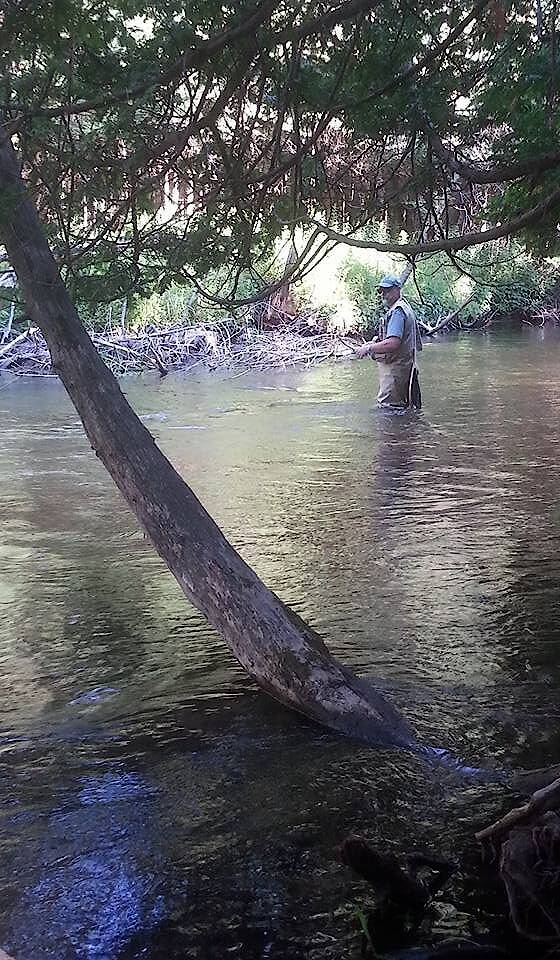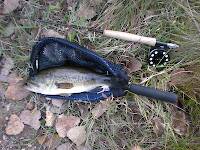
Salmonflies
Pteronarcys californica
The giant Salmonflies of the Western mountains are legendary for their proclivity to elicit consistent dry-fly action and ferocious strikes.
Featured on the forum

This specimen resembled several others of around the same size and perhaps the same species, which were pretty common in my February sample from the upper Yakima. Unfortunately, I misplaced the specimen before I could get it under a microscope for a definitive ID.

Troutnut is a project started in 2003 by salmonid ecologist Jason "Troutnut" Neuswanger to help anglers and
fly tyers unabashedly embrace the entomological side of the sport. Learn more about Troutnut or
support the project for an enhanced experience here.
Roguerat on May 18, 2012May 18th, 2012, 8:34 am EDT
I've finished up my 'cheap bamboo resto-rod' and due to some judicious trimming and all, it's turned out to be 6'-6" and loads best with a 2 wt. line. (I was actually going to buy a 6' graphite or 'glas blank with the components to make a rod and now this!)
Any wisdom or opinion(s) on using a DT vs. WF line for small streams and somewhat smaller trout...8 or 10" is big for where I'm headed. I've used WF-F exclusively until now, 4 through 8 wts and never with a rod less than 8'.
Looking forward to Memorial Day weekend and some days on the Rogue,
Roguerat
I Peter 5:7 'Cast your cares upon Him...'
Any wisdom or opinion(s) on using a DT vs. WF line for small streams and somewhat smaller trout...8 or 10" is big for where I'm headed. I've used WF-F exclusively until now, 4 through 8 wts and never with a rod less than 8'.
Looking forward to Memorial Day weekend and some days on the Rogue,
Roguerat
I Peter 5:7 'Cast your cares upon Him...'
Martinlf on May 18, 2012May 18th, 2012, 9:51 am EDT
I once had a shop owner more or less refuse to sell me a WF for a 7.5 ft. 3 wt. He insisted on the DT, and he was persuasive. I've grown to like them for light rods, small streams, and smaller trout. They do mend easier, and once you wear out one side you reverse the ends and start over with a brand new tip since they are symmetrical. At 60.00 or more for premium lines, this can make for a significant savings. For the generally shorter casts, the DT doesn't seem to make any significant difference to me, and for the odd longer cast I haven't had any real problems. Tight lines, and good fishing.
"He spread them a yard and a half. 'And every one that got away is this big.'"
--Fred Chappell
--Fred Chappell
PaulRoberts on May 18, 2012May 18th, 2012, 3:25 pm EDT
I've started to wonder if the current trend of catalogs offering almost all WF isn't a ploy to sell twice the number of lines over time. That's me being pessimistic. Both cast fine -I can throw my entire DTs. For short range fishing I see no reason not to use a DT. Its not uncommon to want to roll cast more than 35ft too.
Entoman on May 21, 2012May 21st, 2012, 9:03 am EDT
Rogue -
All lines have their purposes and I think the argument many raise between the two is a false dichotomy.
For small streams with a 2 wt., casting more than thirty feet of line (or roughly a 45 ft. cast if you include leader and rod length) is rather rare (or should be). There is no difference between the two at this distance or under, excepting the WF will give you more capacity on the reel.
For longer casting on medium to large rivers, where more than the 30 ft. head of a WF would be beyond the rod tip, it is unquestioned that the DT is far superior for mending and line control when executing and fishing casts across or upstream. Downstream casts on the other hand, usually require some feeding of line into the drift. In this circumstance, the WF has the advantage. The WF also has the advantage in stillwater fishing where distance is usually more important than mending.
Modern rod designs and materials have changed things up quite a bit allowing line designers to expand the head lengths of WF's without mushing out rod performance. These lines allow the best of both worlds. Since I feel handicapped with just the line on the reel and usually cut off quite a bit of the back side of a DT line anyway, the "two for one" advantage goes away. I don't like worrying about jamming up the reel if I'm not so careful about winding the line on perfectly.:)
On my 4's and 5's, I go with the expensive long belly designs for general use, On 3's and 2's, there's not as much difference between belly and tip so the more economical trimmed DT's are usually on my reels. One exception is a 3 wt. set up w/ a standard WF I use on Fall R. Upstream casting is anathema there.:) WF's go on all of them for lake fishing.
For creek fishing over small fish, who needs backing? As long as you are sure of this situation, the untrimmed DT alone retains the value of reversibility. If you do a lot of this, it would be a good idea to have a rig set up for this purpose, and the fly shop recommendations were spot on. You wouldn't be happy with that setup on the Henry's Fork or Silver Creek, though. Tackle selection is always circumstantial! :)
BTW - Consider moving up a line wt. or two for your creek fishing ( using a 3 wt on your 2 rod). Those short 15 - 30 ft. casts will load the rod better.
All lines have their purposes and I think the argument many raise between the two is a false dichotomy.
For small streams with a 2 wt., casting more than thirty feet of line (or roughly a 45 ft. cast if you include leader and rod length) is rather rare (or should be). There is no difference between the two at this distance or under, excepting the WF will give you more capacity on the reel.
For longer casting on medium to large rivers, where more than the 30 ft. head of a WF would be beyond the rod tip, it is unquestioned that the DT is far superior for mending and line control when executing and fishing casts across or upstream. Downstream casts on the other hand, usually require some feeding of line into the drift. In this circumstance, the WF has the advantage. The WF also has the advantage in stillwater fishing where distance is usually more important than mending.
Modern rod designs and materials have changed things up quite a bit allowing line designers to expand the head lengths of WF's without mushing out rod performance. These lines allow the best of both worlds. Since I feel handicapped with just the line on the reel and usually cut off quite a bit of the back side of a DT line anyway, the "two for one" advantage goes away. I don't like worrying about jamming up the reel if I'm not so careful about winding the line on perfectly.:)
On my 4's and 5's, I go with the expensive long belly designs for general use, On 3's and 2's, there's not as much difference between belly and tip so the more economical trimmed DT's are usually on my reels. One exception is a 3 wt. set up w/ a standard WF I use on Fall R. Upstream casting is anathema there.:) WF's go on all of them for lake fishing.
For creek fishing over small fish, who needs backing? As long as you are sure of this situation, the untrimmed DT alone retains the value of reversibility. If you do a lot of this, it would be a good idea to have a rig set up for this purpose, and the fly shop recommendations were spot on. You wouldn't be happy with that setup on the Henry's Fork or Silver Creek, though. Tackle selection is always circumstantial! :)
BTW - Consider moving up a line wt. or two for your creek fishing ( using a 3 wt on your 2 rod). Those short 15 - 30 ft. casts will load the rod better.
"It's not that I find fishing so important, it's just that I find all other endeavors of Man equally unimportant... And not nearly as much fun!" Robert Traver, Anatomy of a Fisherman
Roguerat on May 22, 2012May 22nd, 2012, 10:10 am EDT
fellow fly-fishers (I'm feeling alliterative today, I guess)
thanks much for the info and informed opinions,and I think I'm heading toward a DT-3 for the resto-rod. I doubt I'll be casting more than 25-30 feet- at the most- and that will be quartering upstream where the casting-lane is most amenable to this distance.
tight lines right back, and if you see a Dave's Hopper hung in a tree you'll know I've been there...
Roguerat
I Peter 5:7 'Cast your cares upon Him...'
thanks much for the info and informed opinions,and I think I'm heading toward a DT-3 for the resto-rod. I doubt I'll be casting more than 25-30 feet- at the most- and that will be quartering upstream where the casting-lane is most amenable to this distance.
tight lines right back, and if you see a Dave's Hopper hung in a tree you'll know I've been there...
Roguerat
I Peter 5:7 'Cast your cares upon Him...'
Entoman on May 22, 2012May 22nd, 2012, 10:48 am EDT
alliterative
Cool word!
BTW - There's another tidbit you may consider since a six ft. rod is very specialized gear. Buy a mid-priced DP and cut it in half. You will have in effect two 45 ft. heads you can connect to backing. The advantage is that you not only have two lines for the price of one, but the unused half (if sealed in a plastic bag & kept in the dark) will stay new indefinitely. Loaded on the reel underneath the used front half is not quite the same. There is some oxidation & UV damage still taking place and with moderate priced lines it will loose it's suppleness almost as fast. I don't spend as much time on small waters so I throw that Fall R. setup (WF3) I mentioned on a little 7 ft. 2 wt. & it works great. I do have friends though that quasi-specialize in small creeks and they swear by the 45 ft. head method. They have fished for years doing this and land some surprisingly large fish on occasion - and they've never seen their backing.
Of course, they don't fish the larger spring creeks much and when they do they'll use their 4 wt's. If you have a longer 3 wt for use on bigger rivers (like I do), cutting the line would be a little extravagant. Out West we struggle a but more with air movement so IMHO the 3 wt is at about the limits of practicality, but it's my favorite for presenting small flies to picky fish.:)
"It's not that I find fishing so important, it's just that I find all other endeavors of Man equally unimportant... And not nearly as much fun!" Robert Traver, Anatomy of a Fisherman
Risenfly on Dec 18, 2012December 18th, 2012, 10:11 am EST
For the taper of a fly line, there is no difference between a WF and a DT in the same line. The DT has no real belly and then has a reverse taper so you can eventually flip it. On small streams where you're never going to cast the whole taper then a DT will potentially double the life of your line. I say potentially because a line will degrade from UV light and wear and tear on your rod. With inexpensive lines out there now, I don't think it really makes a difference for the application you need. Nothing special needed for a max 20ft cast to fish in small mountain streams.
www.risenfly.com
Fly reels, lines, boxes and accessories. Rods coming in 2014!
Fly reels, lines, boxes and accessories. Rods coming in 2014!
Quick Reply
Related Discussions
Topic
Replies
Last Reply
1
Jun 3, 2013
by Brookyman
by Brookyman
4
May 15, 2008
by Vermonter
by Vermonter
10
Sep 1, 2007
by Wiflyfisher
by Wiflyfisher
10
Sep 25, 2010
by Motrout
by Motrout
2
May 17, 2018
by Subway
by Subway










